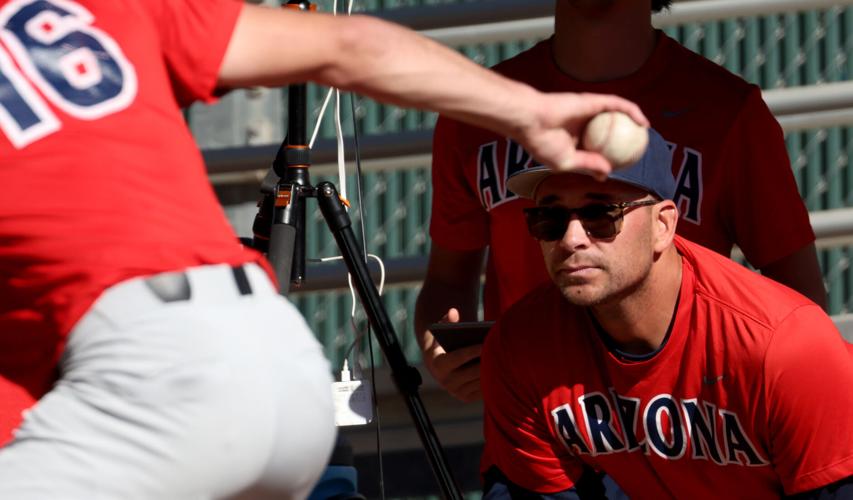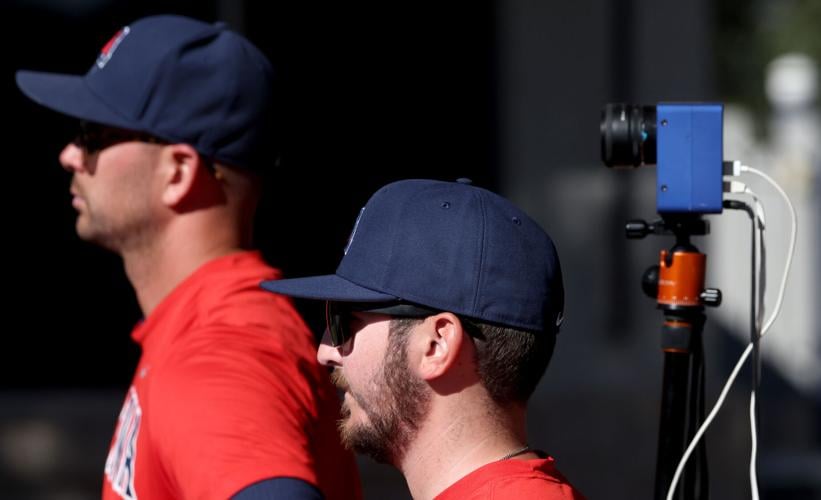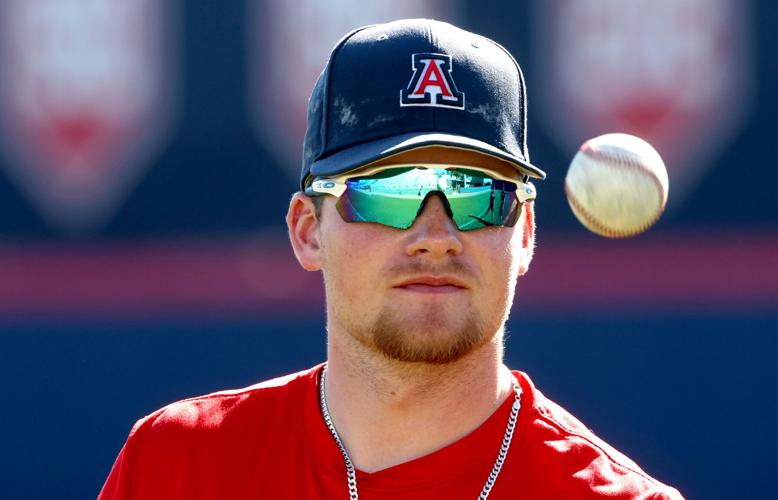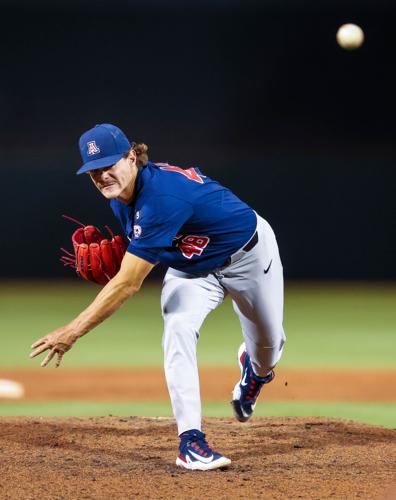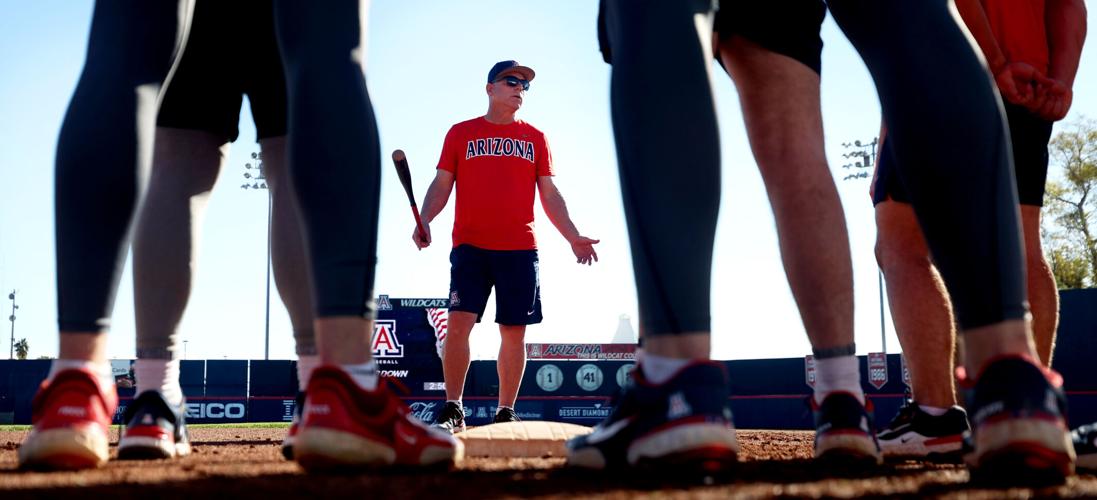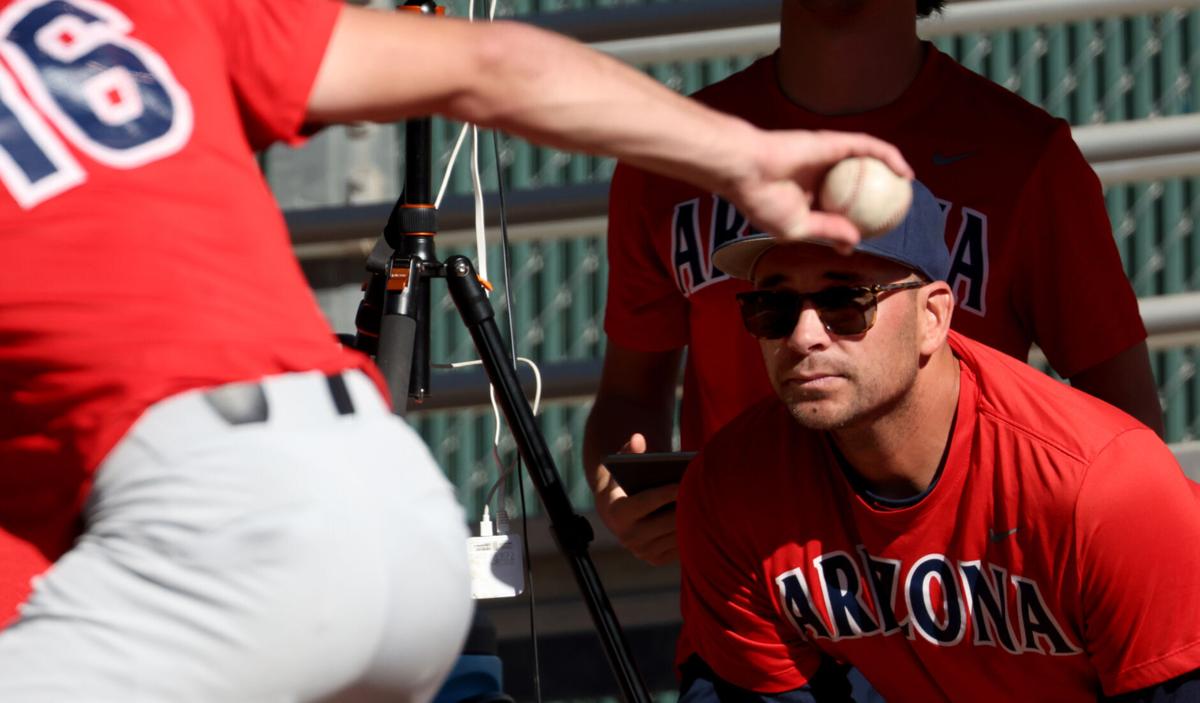Asked recently about specific areas where Arizona’s pitchers could improve this season, Wildcats coach Chip Hale offered a blunt assessment.
“They need to do everything better,” he said. “That's why we made the change.”
After two seasons of struggles on the mound, Hale had no choice but to initiate a reboot. He parted ways with pitching coach Dave Lawn and hired Kevin Vance from Boston College, which was coming off its first NCAA Tournament berth since 2016. The UA then added John DeRouin as director of player development to be Vance’s right-hand man.
Ever since, as Vance put it, they’ve been nerding out.
Embracing a movement that has transformed MLB pitching and has infiltrated the college game, Vance and DeRouin are using science, data and technology to optimize Arizona’s arm talent. The program dabbled in data and tech before; Vance and DeRouin are leveling up.

UA coach Chip Hale gathers the team to discuss base running during practice at Hi Corbett Field as Arizona baseball gets ready for the upcoming season on Jan. 31, 2024.
The pitching staff is unequivocally on board. So is Hale.
“You have to maximize whatever skill you have,” said the third-year head coach, whose team opens the 2024 season Friday vs. Northeastern. “If you're gonna put your head in the sand and be old school and just say that’s a bunch of BS ... things change. The game changes over the years. If you don't change with it, or you don't adapt, you die.
“It's my job as the head coach to maximize every kid and give them a chance to go to the next level of play. Is that going to happen? No. But it's our job to get them to where they should be. To at least try to get drafted. I didn't feel like that was happening.”
Arizona’s pitchers weren’t getting the most out of their ability; extracting that is the overarching theme of the program Vance and DeRouin have implemented.
The Wildcats ranked 24th nationally in an advanced metric called “stuff+” last season. Stuff+ mainly factors in a pitch’s velocity and movement; it doesn’t account for location or result.

New Arizona director of player development John DeRouin, right, watches some of the Wildcat pitchers throw from the mound with pitching coach Kevin Vance during practice at Hi Corbett Field on Jan. 31, 2024.
Arizona ranked 157th nationally in ERA (5.97) and 152nd in WHIP (1.62). The Wildcats snuck into the NCAA Tournament but went two-and-out. They were outscored 21-7.
In Hale’s two seasons, Arizona has averaged 7.47 runs per game. When the Wildcats have scored five or fewer runs under Hale, their record is 12-37.
Something had to change. How much that change impacts the 2024 Cats will be the story of the season.
Movement matters most
In seeking a new pitching coach, Hale, 59, wanted someone on the younger side; someone who had expertise in analytics and biomechanics; and someone who could help make the pitching staff mentally tough.
Vance is 33 years old. He made it as high as triple-A in the Diamondbacks organization. He earned his undergrad degree at UConn in Kinesiology, Coaching & Sport Administration. He completed a master’s degree at Northeastern in Sports Leadership.
Vance began his coaching career at his alma mater and eventually became the pitching coach and recruiting coordinator at Rhode Island and Boston College.
It was in the Northeast that Vance met DeRouin, a former high school and junior college pitcher who was tutoring young hurlers at an athletic training facility in Rhode Island. Vance sent some of his pitchers to work with DeRouin, who was utilizing technology such as TrackMan to break down pitchers and their offerings. DeRouin, 23, spent a year in the Detroit Tigers organization as rehab pitching coordinator before coming to Tucson.
“He's one of the guys that I would talk to on the phone for hours about pitching,” Vance said. “We picked each other's brains. So when the (UA) job opened up, it was like, ‘Yeah, I would love to have someone that I know that we've already bounced ideas off each other.’ We understand where we're both coming from and what's important.”

UA lefty Jackson Kent tosses a ball in the outfield as the Wildcats get ready for their afternoon practice at Hi Corbett Field in January.
Their initial focus is on movement. How does each pitcher’s body work best?
As with all aspects of their program, each player is viewed as an individual. The recommended tweaks and adjustments for 6-3 left-hander Jackson Kent aren’t the same as for 5-8 right-hander Tony Pluta. Vance describes that process as “understanding themselves so that they can go and be themselves.”
“We’re pitchers, but we’re all not the same,” Kent said. “So they're making changes based on that.”
Once they’ve assessed how a pitcher most efficiently moves down the mound, the nerding out begins. Vance and DeRouin recommend different grips, arm slots and plans of attack. “Pitch design” is a term you’ll hear a lot in this world.
All of it is data-driven. The coaches are able to show their pupils which pitches are most effective based on their spin rates, their horizontal and vertical breaks and other information.
“It’s on the screen right there,” Vance said, pointing to a monitor mounted in his office at Hi Corbett Field. “You can prove it with the data.”
Keeping it simple
The data can be overwhelming. One of DeRouin’s recent social media posts focused on the unique shape of right-hander Casey Hintz’s changeup. It featured a Trackman dashboard full of numbers and graphs.
Another post talked about “infrasternal angles” — basically, the size and shape of one’s ribcage — and how pitchers with wider angles should operate differently than those with narrower ones.
How to make all that complex information digestible for baseball players is the challenge — and an area where Vance and DeRouin excel.
“They keep it really simple for us,” senior left-hander Bradon Zastrow said. “One thought beats multiple different analytic ideas. (They) give you a cue for something that they see that is given to them by the analytics and numbers.”
“They're both unreal communicators,” junior right-hander Anthony “Tonko” Susac said. “They have unbelievable knowledge, and they're able to communicate it to you in an effective way.
“It's not always about just knowing it. People say you don't really know something until you can explain it to a fifth-grader. They can explain it to anybody.”
Vance and DeRouin emphasize communication and simplification as much as individualization and experimentation. As DeRouin puts it, “We gotta make the main thing the main thing, and that's getting outs at a high level and competing.”
“At the end of the day,” Vance said, “it's simplified into throw this pitch in this area, do it as often as you can and then do it again, just one pitch at a time.”
Positive changes
Kent and Zastrow are two of many UA pitchers who’ve made changes under Vance and DeRouin’s direction, elevated their performance and expanded their roles.
Kent added more “coil” to his windup, and it has unlocked his velocity. He’d been sitting in the 88- to 89-mph range. Now he’s 91-93, topping out at 94.

UA lefty Jackson Kent hurls a practice ball at the team’s afternoon workout at Hi Corbett Field. Kent made a change to his motion, and it has elevated his velocity. He could start on opening night Friday.
“I'm getting more into my back leg,” Kent said. “My lift-up leg is coiling more so than I'm able to get a lot of tension and then letting it go as I hit the ground — staying connected into the back leg the whole time.”
Kent made 18 appearances, including four starts, as a redshirt freshman last season. He posted a 5.71 ERA. Now, he’s slated to start on opening night.
Zastrow started in 15 of his 17 appearances last year, going 6-5 with a 5.28 ERA. He’s now ticketed to be a multiuse, multi-inning reliever who, according to Vance, could lead the team in appearances.
The biggest change Zastrow made? Lowering his arm angle so that he’s releasing the ball about nine inches closer to the ground. It felt unnatural at first, Zastrow said. Now, it feels smooth, and there’s less strain on his body.
“We revamped my whole game, dropped my slot, changed my arm motion, changed some grips on my pitches, and it's really allowed me to elevate and have better stuff,” Zastrow said. “I've been waiting for development like this my whole life.

Arizona starter Bradon Zastrow pitches during the third inning of the Wildcats' game against Stanford in the Pac-12 Tournament semifinals at Scottsdale Stadium on May 26, 2023.
“I grew up just throwing strikes — get in the zone and compete. Adding Kevin and John to the equation has just changed my game tremendously.”
Susac is something of a work in progress. Former UA catcher Daniel Susac’s cousin was a big-time recruit in the class of 2021. A combination of injuries and inconsistency led to a 7.55 ERA over the righty’s first two seasons — despite him having some of the best stuff on the staff.
“He has one of the best breaking balls on the team,” Vance said. “But he's not getting swings on it.”
While the data showed that the pitch had great life, it also revealed that it wasn’t in the strike zone long enough to fool right-handed hitters. Moving Susac to the third base side of the pitching rubber was considered a possible solution to create a better angle. He’s also throwing his fastball with more “vert” and “ride” to generate greater contrast with his breaking pitches.
Susac considers himself a “very analytical person.” He says Vance and DeRouin “speak my language.”
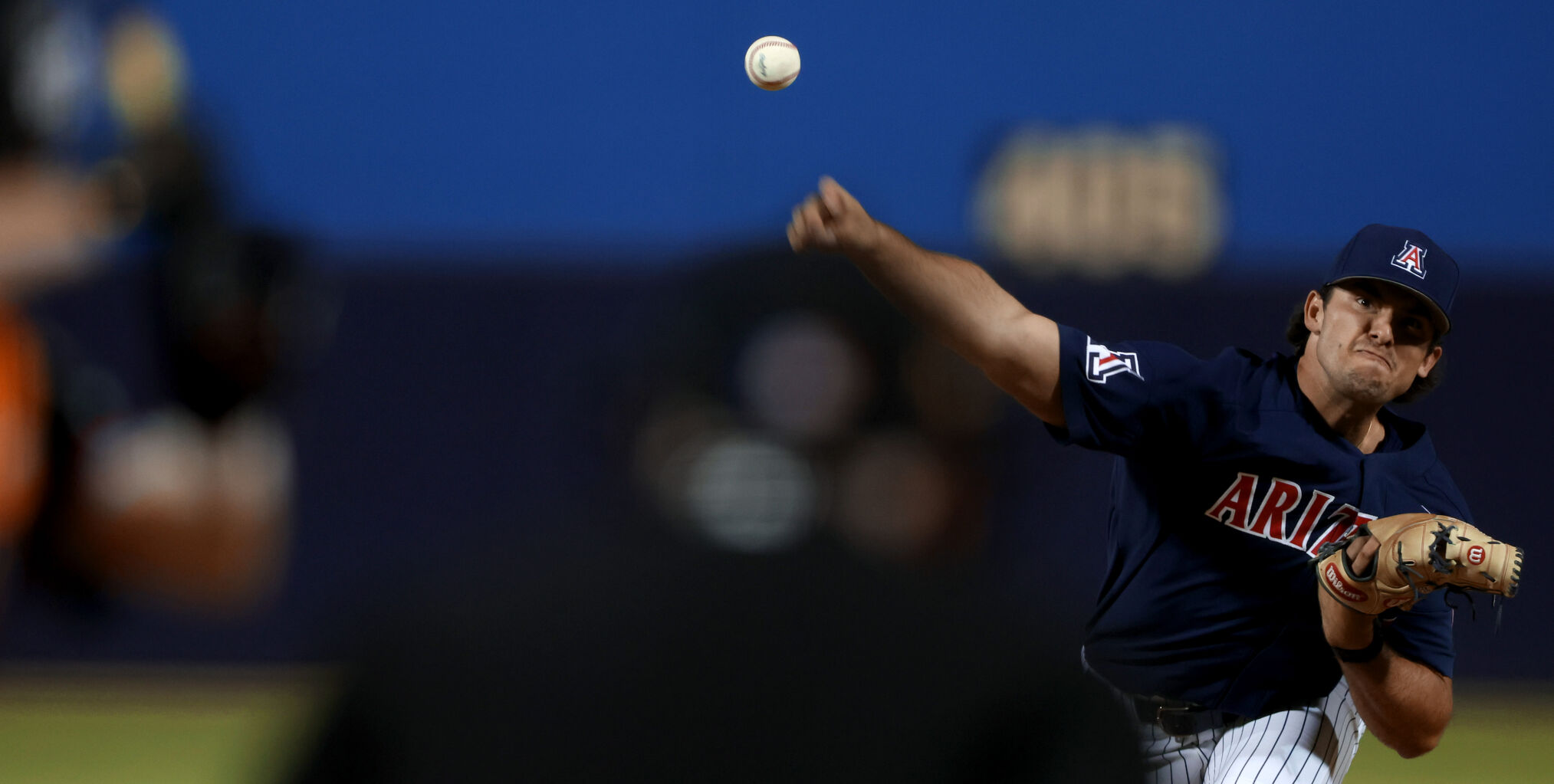
Arizona's Anthony Susac deals against Hermosillo in their game at the Mexican Baseball Fiesta at the Kino Sports Complex on Oct. 5, 2023.
“Those guys go home at night, and they think about how they can develop each of us,” Susac said. “They really care.”
The arms race
The new-school approach to pitching in college baseball reached its apex last season, when Wake Forest advanced to the College World Series for the first time since 1949.
In January 2019, the ACC school opened the Wake Forest Pitching Lab — the first facility of its kind on a college campus. The lab’s “vision,” according to its website, is to “transform the future” of the sport “by combining baseball, science and medicine to revolutionize the way pitching mechanics are analyzed and taught.”
The Demon Deacons led the nation in ERA last season. They were the only Division I team to finish under 3.00 (2.83).
Arizona is working on converting part of the Terry Francona Hitting Center into a pitching lab. It’s expected to include KinaTrax motion-capture technology.

New Arizona pitching coach Kevin Vance watches righty Casey Hintz throw during practice at Hi Corbett Field on Jan. 31. Vance has taken the Wildcats' use of technology and data to the next level.
Considering that the UA mostly struck out in the NIL space this past offseason, it’s a prudent use of resources — a way to get an edge in what has become a literal arms race.
“It goes back to everything that we're trying to do here in terms of our decision-making: We don't want to guess,” DeRouin said. “The lab for us is going to push the needle in gaining an understanding of how our guys are moving, where can we be better, tracking things over time.
“When you're trying to win at a high level, you want to make sure that there's consistency. We wanted to get on top of things right away. We don't want to let things slide.”
DeRouin has worked with teenagers seeking college scholarships and pro contracts. The reality is, they’re already using TrackMan, Rapsodo and other technological tools. If your college program isn’t all in on tech and data, it’s behind in the count.
“A lot of kids now — and I know, because I've worked in that world — they come in with some type of training history,” DeRouin said. “We're just trying to give them a north star to work towards. When you can show them through video, through data, through information, ‘This is what we're trying to do, this is what we believe is going to help make you better’ — and they can see it — there's more buy-in.
“This is what kids want. This is what they're hungry for.”


